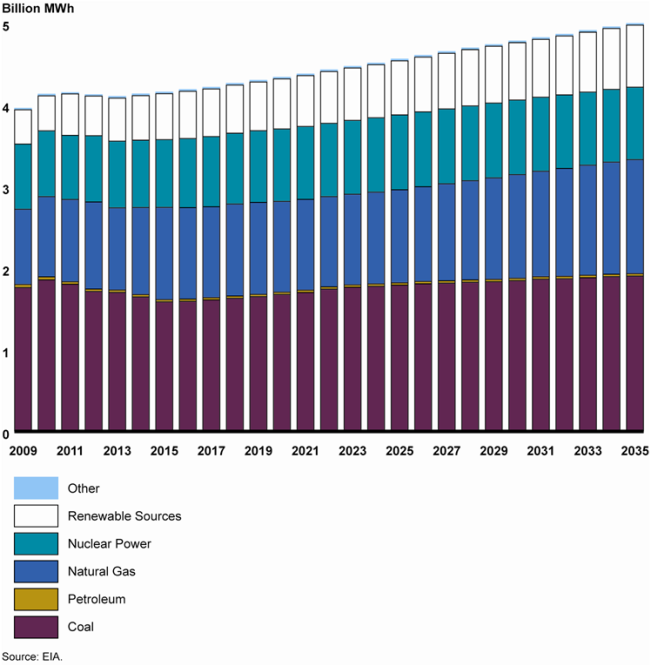
Federal Oversight of Electricity Markets and Infrastructure
Electricity is essential to modern life—providing many services to households and a key resource to U.S. businesses. Production of electricity can lead to environmental concerns including air and water pollution, greenhouse gas emissions, and waste associated with the burning of coal or from spent nuclear fuel. The national electricity system, which was built up over decades, faces a number of challenges, including reliability and security concerns.
Much of the nation’s electricity is produced by private companies at privately-owned power plants, and is sold to consumers in retail markets that are regulated by state and/or local governments. However, the federal government has several important roles in the electricity industry—as a regulator, as a driver of electricity policy, overseeing electricity’s environmental impacts, and as an owner of electricity infrastructure.
Regulator
The Federal Energy Regulatory Commission (FERC) serves as the principal federal regulator of electricity markets and transmission. In recent years, FERC has taken steps to increase the role of markets by, among other things:
- Encouraging the development of independent transmission operators such as Regional Transmission Organizations (RTO). (Figure 1 shows the RTOs operating in the United States.)
- Approving plans for the creation of independently operated, centralized markets
- Taking steps to monitor the competiveness of those markets
Figure 1: U.S. Regional Transmission Organizations

Electricity Policy
Concerns over the long-term availability and price of domestic and international fuel sources, and broader national policy issues such as climate change, have increased the national focus on aspects of electricity policy. The proportion of electricity generated using various fuel sources has been a consistent area of interest to stakeholders involved in questions of national electricity policy. (Figure 2 provides a forecast of how electricity production is expected to change in the future)
Figure 2: EIA Forecast of Electricity Generation, by Fuel Source
Key policy issues pursued in recent years:
- Development of proposed national policies to address climate change, which could affect how electricity is produced and its price.
- Incentives for different fuel sources for electricity.
- Efforts to promote renewable energy and consideration of how to operate transmission grids in order to accommodate the increased use of renewable.
- Impacts of changing fuel prices and regulatory changes on electricity supplies.
- Increased emphasis on real-time pricing of electricity and other forms of demand response—a way to potentially reduce electricity demand by paying consumers to reduce their usage.
Electricity’s Impact on the Environment
Production of electricity can have important impacts on the environment. Producing electricity from fossil fuels can result in air pollution, water impacts, solid waste, and emissions of greenhouse gasses. Some of these impacts are subject to federal regulation and some have been the subject of legislative review. Producing electricity using nuclear power results in radioactive waste that must be stored, but the federal government has not yet completed a waste storage facility and it has been sued by utilities seeking to recover claimed damages resulting from the delay. Efforts to develop a waste repository at Yucca Mountain, in Nevada, have been the subject of ongoing debate. Key areas of GAO examination include:
- Regulations to address environmental impacts from electricity generation
- Efforts to reduce the emission of greenhouse gases from fossil-fueled power plants
- Efforts of the Department of Energy and others to develop a waste repository at Yucca Mountain
- The use of water at electricity plants
Owner of Electricity Infrastructure
The federal government is the largest owner of electricity generating capacity and owns significant transmission assets in the United States. Development of these resources was initially pursued as part of efforts to provide electricity to rural areas and as part of flood control and irrigation efforts. These electricity assets are managed by the following federal entities:
- Tennessee Valley Authority (TVA) (Figure 3 shows TVA’s service area and key generating facilities.
- Bonneville Power Administration (BPA)
- Western Area Power Administration (WAPA)
- Southeastern Power Administration (SEPA)
- Southwestern Power Administration (SWPA)
GAO has examined the operation of these entities, their performance, and other issues.)
Figure 3: TVA Service Area and Key Electricity Generating Facilities

GAO-12-635: Published: Jul 17, 2012. Publicly Released: Aug 16, 2012.
GAO-12-107: Published: Oct 31, 2011. Publicly Released: Dec 1, 2011.
GAO-11-117: Published: Jan 12, 2011. Publicly Released: Jan 12, 2011.
GAO-08-987: Published: Sep 22, 2008. Publicly Released: Sep 26, 2008.
GAO-04-844: Published: Aug 13, 2004. Publicly Released: Sep 13, 2004.
More Reports
GAO-16-487: Published: Sep 8, 2016. Publicly Released: Sep 8, 2016.
GAO-16-641T: Published: May 17, 2016. Publicly Released: May 17, 2016.
GAO-16-243: Published: Mar 24, 2016. Publicly Released: Apr 25, 2016.
GAO-16-106: Published: Dec 10, 2015. Publicly Released: Dec 10, 2015.
GAO-16-171T: Published: Oct 21, 2015. Publicly Released: Oct 21, 2015.
GAO-16-174T: Published: Oct 21, 2015. Publicly Released: Oct 21, 2015.
GAO-15-436: Published: Sep 3, 2015. Publicly Released: Sep 3, 2015.
GAO-15-545: Published: Aug 7, 2015. Publicly Released: Sep 8, 2015.
GAO-15-652: Published: Jul 28, 2015. Publicly Released: Jul 28, 2015.
GAO-15-692T: Published: Jul 22, 2015. Publicly Released: Jul 22, 2015.

